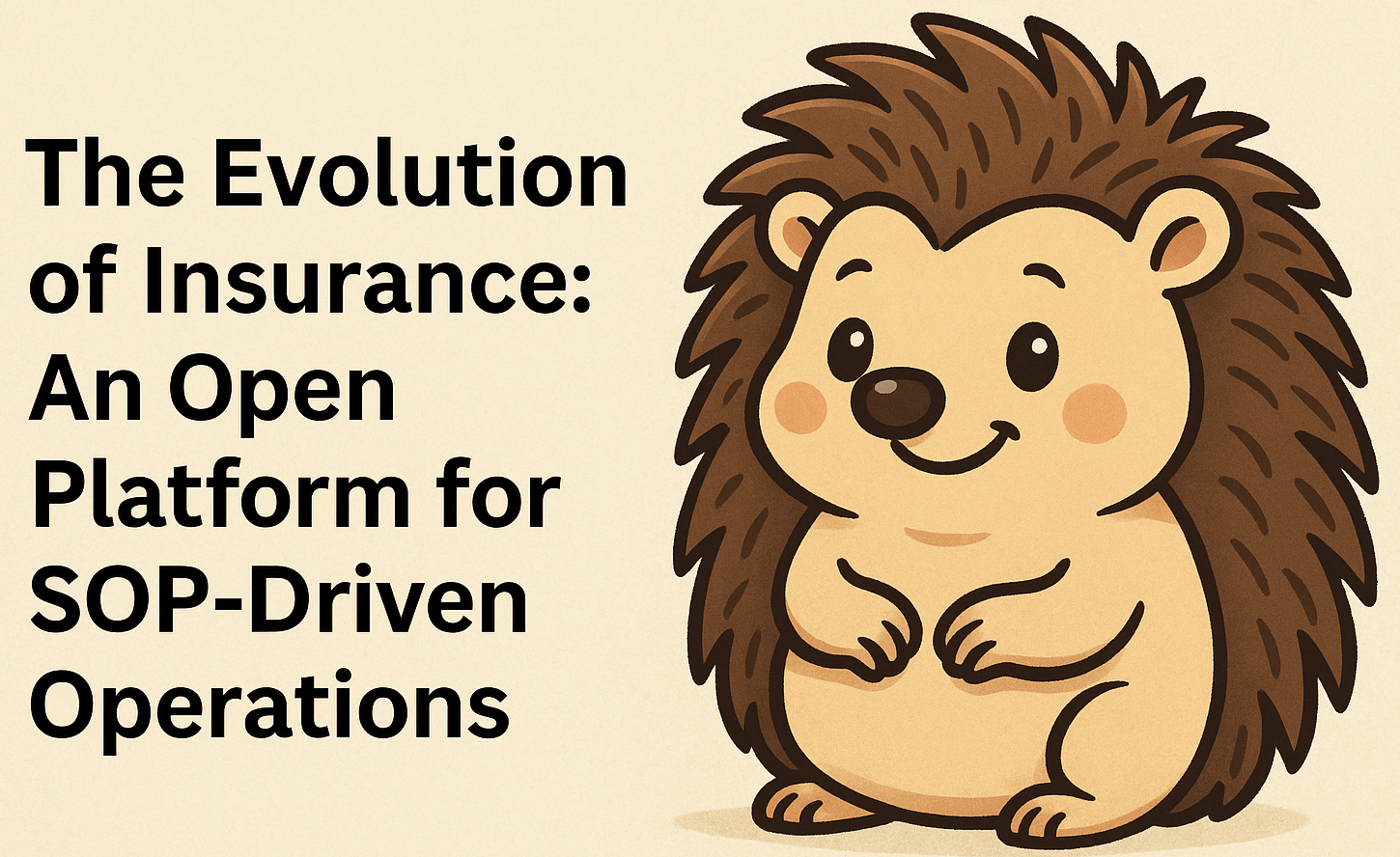ILS part 4 - A Step-by-Step Overview of a Cat Bond

Hi there! Junixy the tech-loving hedgehog back again! Today we're going on an exciting adventure through the life of a CAT bond - from its very first sparkle in an insurer's eye all the way to retirement (or trigger, if disaster strikes!). Think of it as following a recipe for the most fascinating financial dish you've never heard of!
We're going to walk through every step of how these clever risk-transfer tools come to life. From figuring out what risks need protecting, to building the perfect structure, to finding the right investors, and even what happens when a big disaster hits. It's like watching a Broadway show come together - from the first auditions to opening night and beyond!
Risk Identification and Deal Conceptualization
Let’s hop into our first stop: figuring out the biggest, baddest risks out there—and why insurers or reinsurers decide to hand some of that risk off. Think of it like a game of hot potato, except the potato is a hurricane or an earthquake, and we want to make sure no one gets scorched (or drenched!).
a) Identifying the Risk
- Insurers and Reinsurers look at their balance sheets and catastrophe exposure. They seek ways to offload large-scale risks (e.g., hurricane or earthquake risks) to protect their balance sheets and ensure solvency after extreme events.
- They choose to sponsor an ILS (often a CAT bond) because it can offer cost-effective risk transfer, while also opening the door to capital markets—providing a broader investor base than traditional reinsurance alone.
b) Involving Key Stakeholders Early
- Modeling Firms come in to analyze probabilities, simulate potential catastrophic events, and quantify the expected losses. Their models guide how big the bond should be and help estimate the fair premium (coupon) for the risk transfer.
- Brokers advise sponsors on the optimal structure of the bond, suggest the best time to issue, and introduce them to the right investors.
- Legal Firms begin preliminary work to ensure the planned transaction adheres to all regulatory requirements. They also plan for the creation of a Special Purpose Vehicle (SPV).
At this early stage, everyone focuses on understanding the risk exposure and deciding on the coverage needed—this sets the tone for how the deal will be structured.
Structuring the Deal
Step right up—time to build ourselves a shining fortress of hedgehog-proof safety! The bond has to be set up just right: an SPV to keep cash safe, a fancy trigger that tells us “Release the funds!” (or not), and a rating agency’s stamp of approval so investors know where they stand. Let’s roll!
a) Setting Up the SPV
- A Special Purpose Vehicle (SPV) is established—typically in a jurisdiction known for ILS-friendly regulations (e.g., Bermuda). This SPV is legally separate from the sponsor’s other assets and liabilities.
- The sponsor transfers premiums to this SPV, and the SPV issues the CAT bond to investors.
- This separation ensures that if the sponsor faces financial troubles unrelated to the bond, it won’t affect the collateral backing the bond, and vice versa.
b) Defining the Trigger
- One of the most crucial parts of structuring is defining the trigger that determines when investors’ principal may be used to pay the sponsor’s losses.
- Indemnity Trigger: Tied directly to the sponsor’s actual losses from a catastrophe.
- Parametric Trigger: Based on measurable event parameters (e.g., wind speed, earthquake magnitude).
- Industry Loss Trigger: Triggered if the industry-wide losses (as calculated by a third party) exceed a certain threshold.
- Modeled Loss Trigger: Uses a catastrophe model to estimate the sponsor’s losses, and triggers if that modeled loss exceeds a set threshold.
Choosing the right trigger involves balancing transparency for investors and basis risk for the sponsor (i.e., the risk that the sponsor’s actual losses differ from the trigger calculation).
c) Credit Enhancement
- Rating Agencies (e.g., Standard & Poor’s, Moody’s) assess the deal structure, examine the expected loss, the SPV’s setup, and the reliability of the trigger.
- The agencies assign a rating that reflects the likelihood of default (i.e., how probable it is that a triggering event will occur and principal will be lost).
- A higher rating usually attracts more conservative investors and could lower the cost of capital for the sponsor. However, if the risk is high or the structure is complex, the rating might be lower, offering higher yields to compensate investors.
Marketing and Pricing the Deal
Can you hear the carnival barker calling, “Step right up! CAT bonds for sale!”? The next step is all about telling investors why this bond is the coolest new attraction in town—and nailing down the perfect price for that risk. Let’s strike up the band and bring in the crowds!
a) Investor Education and Outreach
- Brokers organize investor roadshows, pitching the risk and return profile to institutional investors, such as pension funds, hedge funds, and specialized ILS funds.
- ILS Managers are pivotal here, as they manage portfolios of ILS for investors who may not have the expertise to underwrite these risks themselves. They analyze the deal on behalf of their clients and decide how much capital to allocate.
b) Setting the Coupon
- The modeling firm’s risk analysis and the rating agency’s opinion guide the sponsor and brokers on a fair coupon rate (yield) that will attract investors. This coupon compensates investors for the catastrophe risk.
- Demand from investors also plays a big role: if demand is high, the coupon might be set lower; if demand is weak, the sponsor may need to raise the coupon to draw in more capital.
Issuance
Lights, camera, action! This is where the rubber meets the road. All that planning and marketing lead to the big moment: finalizing documents, gathering investments, and officially “launching” the bond. Ready to roll?
a) Finalizing Legal Documentation
- Legal Firms finalize the documentation for the ILS transaction. They ensure compliance with securities regulations and finalize the SPV structure.
- The offering documents detail the size of the bond, the trigger mechanism, the term (usually 1–5 years), and the use of collateral.
b) Capitalization of the SPV
- Investors purchase the CAT bond through the SPV. The proceeds (principal) are deposited, usually into high-quality collateral such as U.S. Treasury Money Market Funds, to ensure that the funds are available if the bond triggers.
- The sponsor pays periodic premiums to the SPV, which are then passed on to the investors as the coupon payment. This is typically done quarterly or semi-annually.
c) Closing the Deal
- Once the bond is fully placed (i.e., all the capital is raised), the transaction closes.
- The SPV is now responsible for holding and investing the collateral, collecting premiums from the sponsor, and paying the coupons to investors.
Ongoing Management
The show doesn’t stop once the bond is out in the wild! Keeping tabs on storms, quakes, or any whacky event that might trigger your bond is like a hedgehog carefully watching for hawks overhead. Stay sharp, stay ready, and stay informed!
a) Monitoring Risks
- ILS Managers continuously monitor the risk environment—tracking potential storms, earthquakes, or other catastrophic events. They also manage overall exposure levels in their portfolios.
- Brokers and Modeling Firms may provide updates and run new catastrophe model simulations if the sponsor’s exposure changes or if there’s a major event that could affect the bond.
b) Administrative Duties
- The SPV files necessary disclosures and notices.
- Trustees (often appointed in the transaction) oversee the collateral, ensuring the funds are managed safely in line with deal covenants.
- Legal Firms may step in again if any regulatory or contractual adjustments need to be made.
Settlement After a Triggering Event
The big moment: an actual catastrophe hits and we see if the bond’s trigger is met. Will the sponsor dip into investor principal, or do investors keep their spines (and their cash) intact? Let’s scuttle over and find out!
a) Determining Whether the Trigger is Met
- Event Confirmation: After an event (e.g., a Category 4 hurricane making landfall in Florida), data providers and modeling firms verify the severity of the event.
- Calculating Losses: Depending on the trigger type, the sponsor or a third-party calculates actual (indemnity-based) or parameter-based losses.
- Notification: If the losses or event parameters exceed the threshold set in the bond’s documentation, the SPV is notified.
b) Partial or Full Principal Loss
- Once the trigger is officially confirmed, part or all of the investors’ principal (held by the SPV) is used to pay the sponsor for its losses.
- Partial Trigger: If the loss is smaller or if the bond has multiple layers and only one layer is triggered, only a portion of the principal is released.
- Full Trigger: If the losses are large enough, the full principal may be transferred to the sponsor to cover catastrophic claims.
c) Investor Outcome
- Investors lose the portion of principal determined by the trigger. However, if no trigger event occurs during the term of the bond, investors get their full principal back at maturity—plus the coupon payments they received along the way.
Post-Event Review and Future Deals
Phew! Whether a big disaster triggered our bond or not, we can always learn something new. Did the math match real life? Did the structure hold up like a champion? Let’s hop along and review so we can keep improving—or roll into the next bond if everything went swimmingly!
a) Lessons Learned
- Following a triggering event (or near misses), sponsors and investors review the accuracy of the catastrophe modeling, the effectiveness of the bond’s structure, and the efficiency of the settlement process.
- Modeling Firms gather event data to refine their models for future ILS deals.
b) Reevaluating and Renewing
- If the bond was effective, the sponsor may seek to renew or issue a new bond when the existing one matures or is triggered.
- Investors compare the realized outcomes to their expectations, adjust their risk appetite, and decide whether to participate in future ILS issuances.
Role of Each Key Player at a Glance
- Insurers
- Identify catastrophe risks on their balance sheet.
- Sponsor ILS/CAT bonds to offload peak exposures.
- Reinsurers
- Sponsor ILS deals, like insurers, to transfer catastrophe risk.
- Also invest in ILS themselves for diversification and capital efficiency.
- Investors
- Provide the capital by purchasing the CAT bond.
- Seek diversification benefits and attractive yields.
- ILS Managers
- Analyze and manage portfolios of ILS for institutional investors.
- Conduct in-depth catastrophe modeling and market research on behalf of their clients.
- SPVs
- Specially created entities that issue the CAT bonds, ensuring legal/financial separation.
- Manage collateral, collect premiums, and pay coupons.
- Rating Agencies
- Evaluate the risk of the bond and assign a rating, influencing yield and investor appetite.
- Modeling Firms
- Provide the quantitative analysis of potential catastrophic events and expected losses.
- Help sponsors and investors price the CAT bond fairly.
- Brokers
- Act as intermediaries to structure the ILS deal, bringing sponsors and investors together.
- Advise on optimal timing and marketing to maximize success.
- Legal Firms
- Draft legal documentation and ensure compliance with regulatory requirements.
- Set up the SPV framework and finalize transactional details.
So there you have it, fellow spiky explorers! CAT bonds might sound all fancy-schmancy, but at their core, they’re a clever way for insurers and reinsurers to say “nope!” to mega-catastrophe risks, while bold investors get a shot at juicy returns (with a side of thrills). By tossing those peaks of risk into capital markets through a sturdy SPV, everyone wins—insurers get a safety net, investors get a cool new asset class, and the whole system stays resilient. When disaster strikes and the bond trigger says “pay up,” investors chip in for the sponsor’s losses—saving the day, hedgehog style. But if that disaster never shows up? Those sharp-quilled investors keep both their principal and some sweet coupon payments. It’s a neat little dance of risk and reward, powered by top-notch modeling, trustworthy ratings, and rock-solid structure. Until our next CAT bond quest, remember: stay curious, stay spiky, and never lose your sense of hedgehog adventure!


